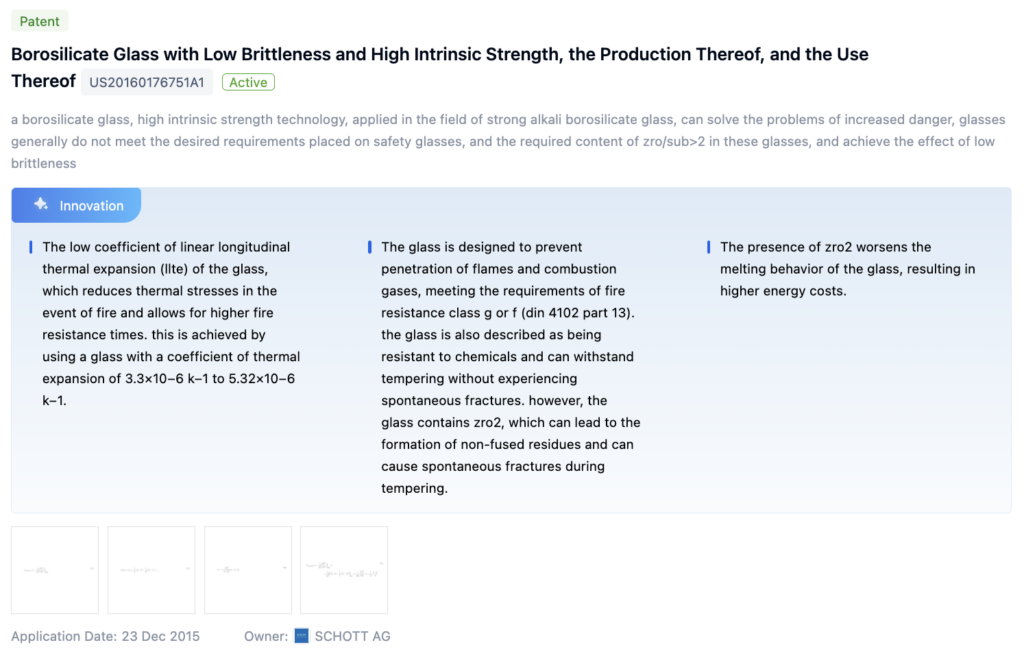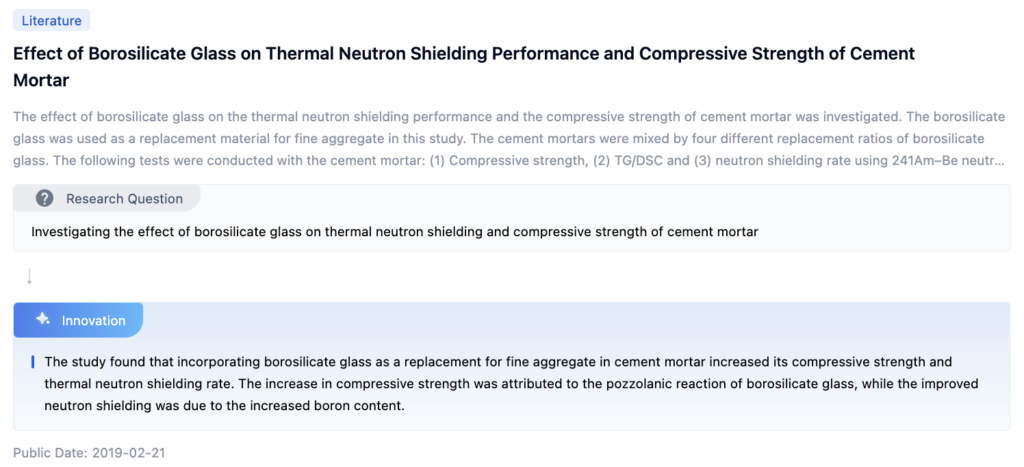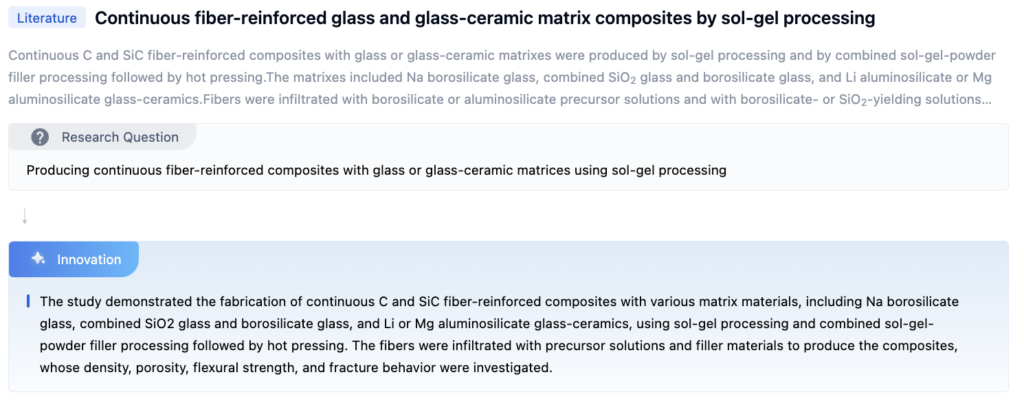
Borosilicate Glass Strengthening Goals
The goal is to enhance borosilicate glass’s mechanical properties to make it more resistant to impact, thermal shock, and other stresses. This will improve product durability, safety, and reliability. Approaches include optimizing chemical composition, modifying manufacturing processes, and introducing novel strengthening techniques. Key objectives is improving the strength of borosilicate glass by increasing fracture toughness and thermal shock resistance, enabling thinner and lighter products while maintaining structural integrity, and expanding the material’s application in demanding industries like aerospace and high-pressure vessels.

To get a detailed scientific explanations of borosilicate glass, try Eureka.
Market Demand for Stronger Borosilicate Glass
Borosilicate glass is essential in industries requiring thermal and chemical resistance, such as pharmaceuticals, chemical processing, and advanced manufacturing. Stronger borosilicate glass is needed for high-pressure and high-temperature environments. Demand is driven by:
- Chemical and Pharmaceutical Industries: Robust glassware for harsh conditions and frequent sterilization.
- Advanced Manufacturing: High temperatures and pressures in 3D printing and precision engineering.
- Safety and Reliability Needs: Aerospace, automotive, and energy sectors require durable components for critical applications.
- Emerging Technologies: Renewable energy and advanced electronics require specialized, durable glass components.
- Miniaturization and Compact Design: Stronger, thinner glass components enable lightweight products without sacrificing performance or safety.
Current State and Challenges in Borosilicate Glass

Despite its advantages, borosilicate glass has limitations such as brittleness, susceptibility to surface flaws, and internal defects. Challenges include:
- Thermal Resistance vs. Mechanical Properties: Enhancing strength often compromises thermal resistance.
- Manufacturing Complexity: Precise control of raw materials, melting temperatures, and cooling rates is crucial.
- Surface Flaws and Internal Defects: Bubbles, inclusions, or cracks act as stress concentrators, leading to premature failure.
Evolution of Borosilicate Glass Technologies

Existing Solutions for Strengthening Borosilicate Glass
Borosilicate Glass Compositions
- High Strength Compositions: Adjusting ratios of silica, boron oxide, and additives like alumina.
- High Boron Oxide Content: Enhances chemical resistance, thermal stability, and mechanical strength.
- Optimized Alkali Content: Balancing chemical durability and workability during manufacturing.
- Added Reinforcing Agents: Incorporating alumina, zirconia, or other oxides to enhance mechanical strength and thermal shock resistance.
- Controlled Thermal Expansion: Adjusting composition to minimize thermal stresses.
- Improved Chemical Resistance: Optimizing the ratio of network formers to network modifiers and incorporating specific additives.
Chemical Strengthening Methods
- Ion Exchange or Thermal Tempering: Creating compressive stresses on the surface.
- Suitable Compositions: Specific amounts of SiO2, B2O3, Al2O3, and alkali metal oxides.
- Chemical Strengthening Products: Tubes, bottles, plates with improved mechanical strength and chemical resistance.
- Continuous and Flexible Processes: Efficient strengthening of thin or flexible glass substrates.
High-Temperature Applications
- Compositions for Extreme Environments: Low thermal expansion and high thermal resistance.
- Preparation Methods: Specific melting and annealing processes with additives or dopants.
- Applications in Various Industries: Solar energy devices, microwave ovens, and furnaces.
Low-Boron Borosilicate Glass
- Reduced Boron Content: Improves UV transparency, chemical resistance, and thermal stability.
- Controlling Boron Volatilization: Techniques to minimize loss during high-temperature melting.
- Specific Applications: Optical glasses, low-temperature co-fired ceramics, medical glasses.
Foam and Porous Materials
- Lightweight and High-Strength Foam Glasses: Applications in thermal insulation, filtration, and catalysis.
Key Players in Borosilicate Glass Industry
Semiconductor Energy Laboratory Co. Ltd.
- Patents: 2234 patents related to borosilicate glass strength.
- Focus: Developing innovative techniques and materials to enhance mechanical properties.
Tianjin University
- Publications: 20 publications on composite materials, additives, coatings, and computational simulations.
- Focus: Advanced composite materials, coatings, and reinforced glass products.
Kyocera Corp.
- Patents: 1492 patents related to borosilicate glass strength.
- Focus: Innovative materials, processes, and techniques to enhance mechanical properties.
Imperial College London
- Publications: 17 publications on composite materials, reinforcing agents, and interfacial properties.
- Focus: Advanced composite materials, reinforced glass products, and interfacial properties.
Core Innovations in Glass Strengthening
Patent 1: Borosilicate Glass with Low Brittleness and High Intrinsic Strength
- Core Points:
- Thermal Expansion: Low coefficient reduces thermal stresses.
- Fire Resistance: Prevents penetration of flames and gases.
- Chemical Resistance: Withstands tempering without spontaneous fractures.

Patent 2: High-Borosilicate Molten Glass Graded Channel
- Core Points:
- Material Quality: Separate outflow of low, medium, and high-grade materials.
- Efficiency: Reduces waste and unqualified materials generation.

Paper 1: Borosilicate Glass on Thermal Neutron Shielding and Compressive Strength
- Core Points:
- Compressive Strength: Enhanced by pozzolanic reaction.
- Neutron Shielding: Improved by increased boron content.

Paper 2: Continuous Fiber-Reinforced Composites by Sol-Gel Processing
- Core Points:
- Composite Fabrication: Continuous fibers with various matrix materials.
- Mechanical Properties: Density, porosity, flexural strength, and fracture behavior.

Potential Breakthroughs in Glass Strengthening
High-Strength Compositions
- Optimized Ratios: Silica, boron oxide, and additives for mechanical properties.
Strengthening Methods
- Chemical and Thermal Tempering: Surface compressive stresses for impact and thermal shock resistance.
High-Temperature Applications
- Specialized Compositions: Solar cell covers, furnace components, and decorative items.
Low-Boron Glass
- Improved Properties: UV transparency, chemical resistance, and solarization stability.
Specialized Applications
- Tailored Compositions: Sealing alumina, foam glass production, colored crystallized glass.
Environmental Impact of Glass Production
Energy Consumption
- High Temperatures: Glass production requires significant energy, typically from fossil fuels.
Greenhouse Gas Emissions
- CO2 Emissions: From fuel combustion and raw material production.
Waste Generation
- Solid Waste: Cullet, broken glass, refractory materials.
- Air Emissions: Particulate matter, nitrogen oxides, sulfur oxides.
- Wastewater: Requires proper treatment.
Water Consumption
- Cooling and Cleaning: Significant water use in production processes.
Raw Material Extraction
- Environmental Impacts: Habitat destruction, soil erosion, water pollution.
Mitigation Strategies
- Energy Efficiency: Improve processes and transition to renewable sources.
- Carbon Capture: Technologies and alternative raw materials.
- Waste Management: Recycling and treatment systems.
- Water Conservation: Reuse and recycling within manufacturing.
- Sustainable Sourcing: Responsible raw material extraction.
Regulatory Landscape for Glass Manufacturing
Environmental Regulations
- Emission Control: Compliance with air quality standards.
- Energy Efficiency: Guidelines for reducing energy consumption.
Safety Regulations
- Worker Protection: Protocols for handling molten glass and hazardous substances.
- Personal Protective Equipment: Requirements for safety.
Quality Control
- Testing and Certification: Ensuring glass meets strength, thermal resistance, and durability standards.
Sustainability
- Recycled Materials: Promoting circular economy principles.
Compliance
- Penalties for Non-Compliance: Significant penalties, legal liabilities, and reputational damage.
- Engagement with Regulatory Bodies: Ensuring understanding and contribution to effective regulations.
If you want an in-depth research or a technical report, you can always get what you want in Eureka Technical Research. Try now!

